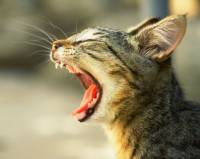
Plaque and bacteria mineralise on cat’s teeth to form tartar or calculus.
Tartar and red inflamed gums, or gingivitis, loosen teeth.
Holes in teeth at the gumline affect 80% of cats. These so-called neck lesions are intensely painful. Tartar builds on them and rubs the inside of the cheek. The only solution is extraction.
Cats with bad mouths show less interest in food or approach the food bowl eagerly then don’t eat. They chew cautiously, drop food from the mouth, or swallow with difficulty. Dribbling, blood-tinged saliva, and bad breath are common. In some cases affected cats paw the mouth or shake the head. Reluctance to eat may lead to weight loss.
Many cats show no signs of bad teeth despite being in pain. However after we clean their teeth they are obviously much happier and relaxed.
A scale and polish under general anæsthesia removes tartar and saves teeth.
Chunks of meat such as gravy beef or chicken thighs encourage chewing and prevent the build-up of plaque and tartar. Greenies are a palatable treat that clean the teeth as well. A bowlful of special dental foods such as Royal Canin dental or Hills t/d several times a week also prevent dental disease. Chewing meat and dental biscuits stimulates the production of saliva, which contains natural antibacterial substances, and scrapes plaque and tartar from the teeth.
Calicivirus vaccination of kittens helps prevent gingivitis.
